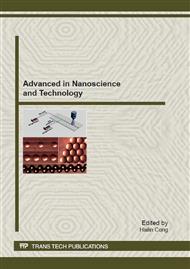p.244
p.248
p.255
p.262
p.268
p.276
p.283
p.287
p.292
Preparation and Physical Properties of ITO Thin Films by Spray Pyrolysis Method
Abstract:
Indium tin oxide (ITO) films were deposited on glass substrates by using the homemade spray pyrolysis system. Orthogonal test was designed to examine the optimal conditions for preparation of the ITO films. The results showed that the ITO thin films can be prepared by the homemade spray pyrolysis device successfully. The device is simple in structure and easy to use. The substrate temperature is the main factor on the photoelectric properties of the ITO films. The optimal conditions for preparing the ITO thin films were as following: the substrate temperature is 300oC, the carrier gas flow of the air was 1.5 L•min-1, the annealing temperature was 500oC, the proportion of the indium and tin was 10:1, the distance between substrate and nozzle was 8 cm, and the deposition time was 3.5 min. The average optical transmittance in the visible range and sheet resistance of the ITO film were 93% and 2786Ω/□, respectively.
Info:
Periodical:
Pages:
268-275
Citation:
Online since:
February 2012
Authors:
Keywords:
Price:
Сopyright:
© 2012 Trans Tech Publications Ltd. All Rights Reserved
Share:
Citation:


